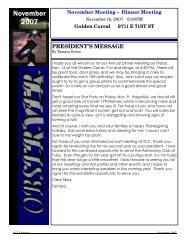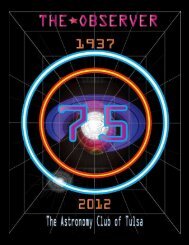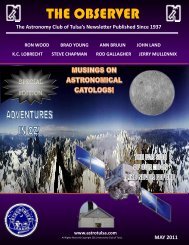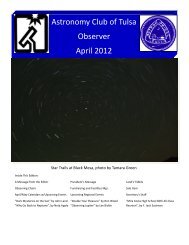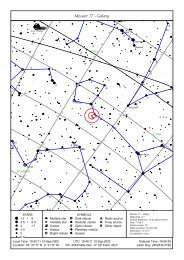Jan - Astronomy Club of Tulsa
Jan - Astronomy Club of Tulsa
Jan - Astronomy Club of Tulsa
Create successful ePaper yourself
Turn your PDF publications into a flip-book with our unique Google optimized e-Paper software.
*NITELOG - Norway InTErurban Local Observing Group*, by Tom H<strong>of</strong>felder, Ct’d.<br />
*STARS:* Three carbons with blue minus visual mags <strong>of</strong> 3.2 to 3.6; maybe not<br />
red enough to knock your socks <strong>of</strong>f completely, but partial removal could<br />
result. The multiple stars include my favorite, 40b Eri, whose components<br />
are 9.5 and 11th mag, so obviously not my fave due to appearance. Not only<br />
is it a unique combination <strong>of</strong> a red dwarf and a white dwarf, but it is the *<br />
ONLY* white dwarf easily seen in small scopes. And the Trapezium, which<br />
normally wouldn't be listed (most objects are ones you may not have seen,<br />
which is why M1 and M42 are not there), is included for the challenge <strong>of</strong><br />
seeing how many <strong>of</strong> the dimmer stars (first attachment) can be seen in your<br />
scope. (Note: crank up the power for that, under a relatively steady sky.)<br />
*THE GOOD STUFF:* Five open clusters (one a Messier), one (the only<br />
winter) globular (also a Messier), two planetaries - one bright, one not<br />
so much, four diffuse nebulae and four galaxies, the most distant (known)<br />
being 90 million ly away. Couldn't find a distance for the NGC 1611 group,<br />
but it is at least 100 million and possibly 150 based on size. And let's<br />
not forget Kemble's Cascade, a lovely sight in binocs or wide field scopes,<br />
being a 2.5 degree long line <strong>of</strong> about 15 stars.<br />
*SUPERNOVA: *Last and definitely not least, how <strong>of</strong>ten do you get to see a<br />
single star 65 million light years away (OK, the bang actually happened<br />
long ago in a galaxy far far away, not this <strong>Jan</strong>uary.) SN 2012ht, a type Ia<br />
in NGC 3447, recently attained a magnitude <strong>of</strong> 12.8. It should remain<br />
around that value for a couple weeks, so - if the limiting magnitudes are<br />
correct in the Trapezium info - an 8 inch would be adequate for detection.<br />
Located in eastern Leo, viewing would commence around 10 PM on the 7th.<br />
*<br />
QUESTIONS:* As always, questions and comments are welcome!<br />
Tom H.<br />
*Come with me now, Pilgrim <strong>of</strong> the stars,<br />
For our time is upon us and our eyes<br />
shall see the far country<br />
and the shining cities <strong>of</strong> infinity* ~ Robert Burnham, Jr.<br />
16



